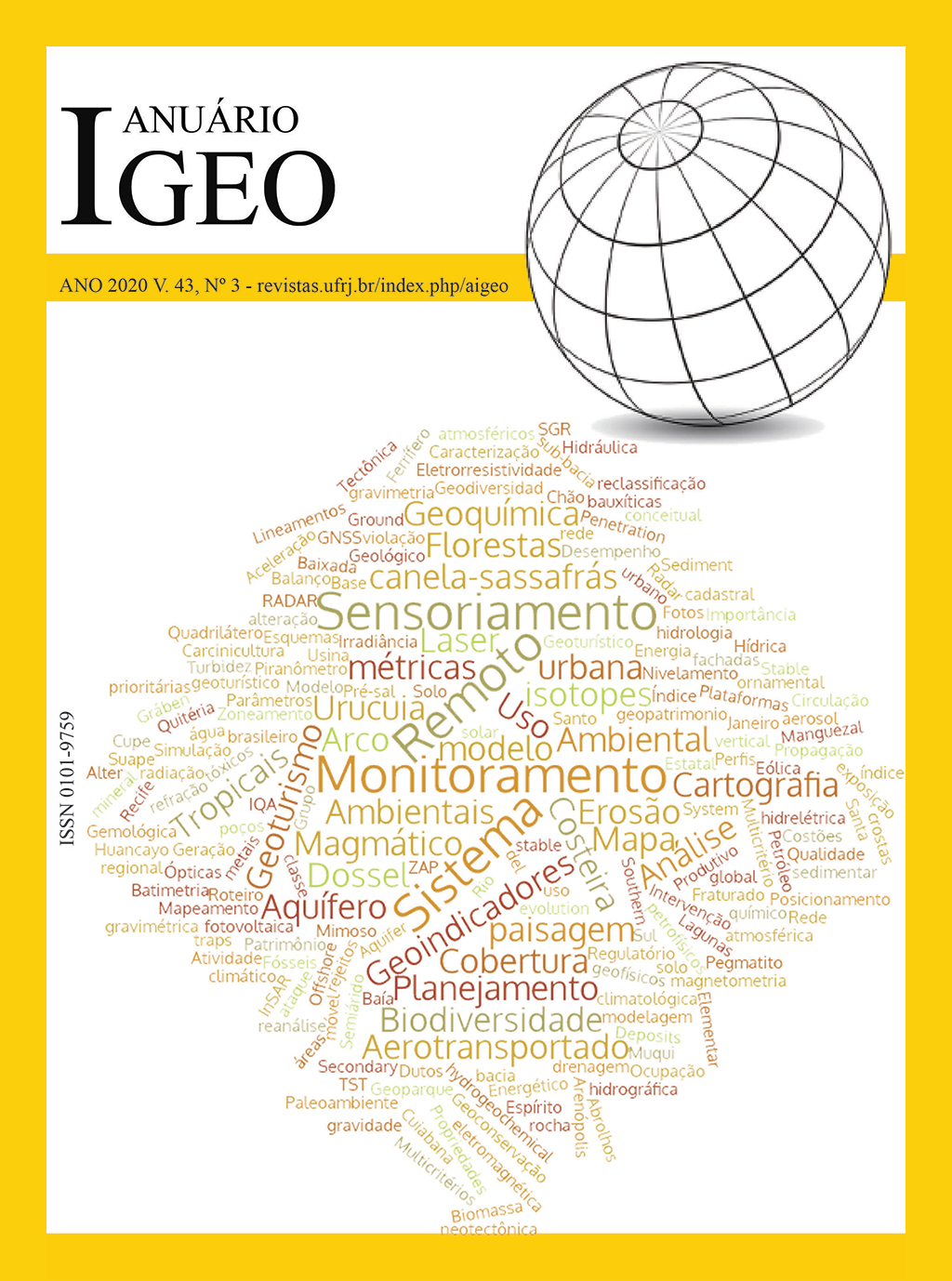Hydrogeochemical and Isotopic (δ2H-δ18O) Investigations of Hydrologic Dynamics of the Southern Urucuia Aquifer System, Brazil
DOI:
https://doi.org/10.11137/2020_3_334_344Palavras-chave:
Southern Urucuia Aquifer System, hydrogeochemical evolution, stable isotopesResumo
The integration of hydrogeochemical and isotopic data (δ2H-δ18O) allowed the reconstruction of the hydrological dynamics of Southern Urucuia Aquifer System. This system is a combination of aquifers that are responsible for the perennity of the rivers during the rainy recession. In this study, water samples were collected from three sources: rainfall, rivers and pumping wells. The hydrogeochemical data lead to subdivide the aquifers in three main types: regional unconfined, confined, and unconfined with deep water level. The unconfined aquifer with deep water level originates from an groundwater flow deflection in the westernmost portion of the study area. The occurrence of silicified and fractured levels divide the aquifer types and represents a mixing and interfaced zone, allowing a leakage between aquifers and a great variability of hydrogeochemical facies. The hydrogeochemical evolution occurs by local, intermediate and regional flow systems. The buildup of dissolved solids is the major controlling mechanism of the groundwater composition represented by the systematic changes of anion species from HCO3 to SO4 to Cl, and cationic exchange between Ca and Na. The discharge occurs through the baseflow of rivers, which have hybrid composition between regional unconfined and confined aquifer from Na-Ca-Cl to Na-Cl. The analysis of stable isotopes shows that the surface water and groundwater are located in the same range of values, which indicates a connection between the reservoirs. During the rainy season, the regional unconfined isotopic composition becomes similar to the precipitation isotopic composition, with the main recharge occurring mostly by direct infiltration of rainwater. However, there is a modification of this composition in the dry season due to strong isotopic enrichment caused by the evaporation process. The seasonal variation in the isotopic composition represents a continuous cycle. In other words, as the rainy season approaches, the atmospheric air column becomes increasingly saturated with water vapor, what results in a considerably diminishment of evaporation.
Referências
Aquino, R.F.; Nascimento, K.R.F.; Rodrigues, Z.R.; Vieira, C.; Maia, P.H.P. & Costa, A.B. 2003. Caracterização hidrogeoquímica e isotópica das águas superficiais e subterrâneas do Oeste baiano – bacia do rio das Fêmeas – Bahia. In: ABRH, XV SIMPÓSIO BRASILEIRO DE RECURSOS HÍDRICOS, Curitiba, 2003. Resumos Expandidos, Curitiba, 20p.
Barbosa, N.S. 2016. Hidrogeologia do Sistema Aquífero Urucuia, Bahia. Programa de Pós-Graduação em Geologia, Universidade Federal da Bahia. Tese de Doutorado, 168 p.
Brand, W.A.; Avak, H.; Seedorf, R.; Hofmann, D. & Conradi, T. 2000. New methods for fully automated isotope ratio determination from hydrogen at the natural abundance level. Isotopes in Environmental and Health Studies, 32(2-3): 263-273.
Campos, J.E.G. & Dardenne, M.A. 1999. Distribuição, estratigrafia e sistemas deposicionais do Grupo Urucuia – Cretáceo Superior da Bacia Sanfranciscana. Geociências, 18(2): 481-499.
Craig, H.C. 1961. Isotopic variations in meteoric waters. Science, 133: 1702-1703.
Epstein, S. & Mayeda, T.K. 1953. Variation of 18O content of waters from natural sources. Geochimica et Cosmochimica Acta, 4: 213-214.
Gaspar, M.T.P. & Campos J.E.G. 2007. O Sistema Aquífero Urucuia. Revista Brasileira de Geociências, 37(4): 216-226.
Honório, B.A.D. 2007. Água da Chuva na Amazônia Ocidental: Química e Composição Isotópica. Programa de Pós-Graduação em Geociências, Universidade Federal do Amazonas, Dissertação de Mestrado, 75p.
Nascimento, K.R.F. 2003. Uso conjunto das águas superficiais e subterrâneas da sub-bacia do rio das Fêmeas-Bahia. Relatório final, ANA/GEF/PNUMA/OEA, Superintendência de Recursos Hídricos (SRH), Salvador-BA, 208p.
Nascimento, K.R.F.; Costa, A.B.; Zucchi, M.R.; Matos, C.R.A.; Azevedo, A.E.G. & Pedreira, C.B. 2003. Oxygen Isotopic composition of surface and ground-waters from rio das Fêmeas sub-basin – Urucuia aquifer – BA, Brazil. In: IV SOUTH AMERICAN SYMPOSIUM ON ISOTOPIC GEOLOGY, São Paulo, 2003. Short Papers, São Paulo, p. 457-460.
Piper, A.M. 1944. A graphic procedure in the geochemical interpretation of water analysis. Transactions, American Geophysical Union, 25: 914-23.
Rice, E.W.; Baird R.B. & Eaton, A.D. 2017. Standard Methods for the Examination of Water and Wastewater, 23st edition. Washington, D.C. American Public Health Association, American Water Works Association, Water Environment Federation, 277p.
Rozanski, K.; Araguás-Araguás, L. & Gonfiantinni, R. 1993. Isotopic patterns in modern global precipitation. In: SWART, P.K., LOHMANN, K.C.; MCKENZIE, J. & SAVIN, S. (Eds.). Climate Change in Continental Isotopic Records. American Geophysical Union, Geophysical Monograph 78, p. 1-36.
Schuster, H.D.M.; Cruz, J.L.F. & Silva F.F. 2010. Modelagem do efeito de bombeamento na depleção de rios. Simulações de um caso real no oeste da Bahia. Revista Ambiente Mineral, 1: 20-35.
Downloads
Publicado
Edição
Seção
Licença
Os artigos publicados nesta revista se encontram sob a llicença Creative Commons — Atribuição 4.0 Internacional — CC BY 4.0, que permite o uso, distribuição e reprodução em qualquer meio, contanto que o trabalho original seja devidamente citado.
















 Exceto onde indicado de outra forma, o conteúdo deste site é licenciado sob uma licença
Exceto onde indicado de outra forma, o conteúdo deste site é licenciado sob uma licença 